 |
The Saint of the Day
St. Charles Borromeo – November 4
Prof. Plinio Corrêa de Oliveira
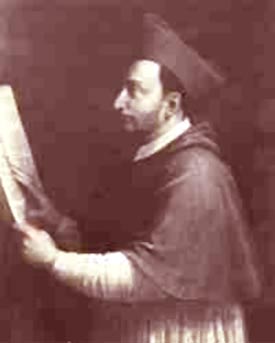
St. Charles Borromeo applied the principles of the Council of Trent to the life of the Church. |
Biographical selection:
St. Charles Borromeo (1538-1584), Bishop and Confessor, was called by God to execute a true reform in the Church. The happy conclusion of the Council of Trent is in great part due to his prudence. Cardinal at age 23, he was given the archbishopric of Milan. He presided over synods and councils, established colleges and congregations, and renewed the spirit of his clergy and the religious Orders. He was the founder of the diocesan seminaries.
St. Charles Borromeo put into practice the decisions taken at the Council of Trent. He had both the natural and supernatural gifts necessary to be a holy Bishop. His sole aim was to realize the model of the perfect Bishop. All his life was ordained to this ideal. In him, the man disappeared and only the Prelate appeared, manifesting splendorous sanctity.
Comments of Prof. Plinio:
Something that can be noticed in History is that when a people reach an apogee, great men start to appear. And many of these great men are so closely bound to the post that they occupy that the person almost seems to disappear and only the position shines. Let us consider some examples.
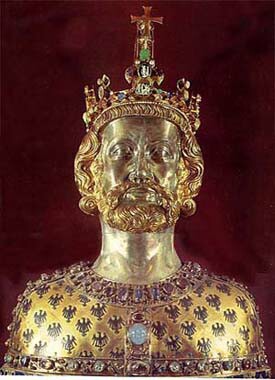
Above, Charlemagne, the Emperor par excellence.
Below, St. Charles Borromeo, the model for Bishops
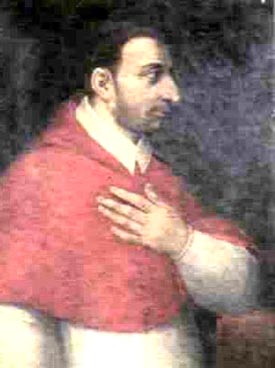 |
There is one man who until today is the Emperor of Emperors, the perfect and definitive pattern for all Emperors. This is so true that when one thinks about an Emperor, one thinks foremost of him. He is Charlemagne. After Charlemagne died, the invasions that he had stopped, began again; the Empire that he had built, broke up; the Europe that he wanted to unite, fragmented into many kingdoms and smaller political units; the dynasty he founded, was extinguished. Everything would lead to the conclusion that his memory would disappear. But Charlemagne remained forever in the memory of all men as the prototype of the Catholic Emperor, and, therefore, the Emperor par excellence. The memory of Charlemagne endured with all the imperial dignity, plenitude of personality, and elevation of spirit proper to an Emperor sent by God to do His work on earth.
Louis XIV is the French King par excellence, the Sun King; Philip II of Spain was par excellence the King who defended the Faith. In the same way, you can find other personages who personified all the facets of the roles they exercised.
The same rule applies inside the Holy Church of God. St. Gregory VII was the Pope par excellence, St. John Baptist Vianney was the model for all parish priests, and St. Charles Borromeo was the prototype of a Bishop.
As a true Pastor who watches over his flock, he was alert to the way error was being presented at his time and took a strong position against it. Like many other preeminent figures of the Counter-Reformation, he helped Catholic doctrine progress by developing the doctrine that Protestantism denied. In his written works, he deduced new developments from truths already known. His position was always militant, as a Bishop should be. He was not an ecumenical Prelate who accepts little parts of truth that the error might have in order to appease the heretic. He would analyze the ensemble of the heresy he was dealing with and discern its ultimate bad intentions. Then he would refute the error in these malicious points and develop the opposite doctrine of the Church.
St. Charles Borromeo was not only a great Bishop of the Counter-Reformation, but in a certain sense he was the Bishop of the Counter-Reformation. This title is his not just because he was a very learned man, but rather because he became the very archetype of a Bishop. He was not satisfied with writing books against the errors of the time, which he did. But he did even more, he personified the truths he defended in his books. He became the very symbol of what he wrote.
I could describe various facets of St. Borromeo that made him a model Bishop if I had more time. But this would make me late for the meeting that follows this one. So let me summarize his life in an example I find very significant.
A Cardinal, as you know, is supposed to dress with pomp, grandeur, and solemnity to glorify Our Lord Jesus Christ before men. In addition to being a Prince of the Church, St. Charles Borromeo was a temporal Lord in Milan, born into a great and noble Italian family. In his 20s, he was entrusted with the responsible post of Papal Secretary of State. Therefore, he used to dress and appear in great style.
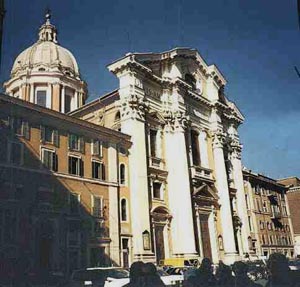
Above, the Basilica of St. Charles Borromeo in Milan, built in honor of the Saint.
Below, the library of St. Charles Borromeo Seminary in Overbrook, PA.
He is patron saint of seminarians.
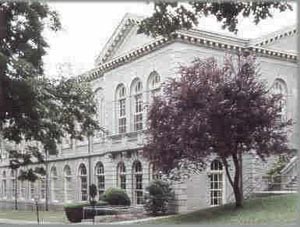
|
Once his carriage was on its way to one of his appointments when a simple friar, who was walking on the road, approached it. St. Charles Borromeo ordered the driver to stop the vehicle. The friar greeted him and said:
“Your Eminence, how nice it must be to live the life of a Cardinal, to wear such splendid clothes and travel in a magnificent carriage! Surely it is much more agreeable than to be a simple friar like me, and walk by foot.”
Cardinal Borromeo kindly invited the friar to accompany him. The friar seated himself next to the Cardinal and the journey re-commenced. Shortly the friar began to cry out in pain, because the beautiful cushions of the benches were placed over a board of sharp iron nails of penance that the Cardinal normally used to mortify himself. The pain became more acute with every movement of the vehicle. The friar could not support such mortification, and begged that the carriage stop for him to get out. Relieved, he returned to his "walk by foot."
That is to say, the silks and crystals of the luxurious carriage were meant to be seen by the people to glorify God and the dignity of his post. Underneath the splendid appearance of a Cardinal, the Saint continued to practice penance for his sins and those of his flock.
We can ask St. Charles Borromeo to intercede with Our Lord and Our Lady for several things on his feast day:
- for the reform of today’s Bishops who so often are very different from the model he represented,
- for the restoration of the seminaries, so immersed in bad morals and false doctrine,
- and finally, for the restoration of the entire Holy Catholic Church today as he helped to restore her in his times.
For ourselves personally, we might ask him to give us his vigilance against heresy and his heroic sense of sacrifice.


  | | Prof. Plinio Corrêa de Oliveira | |
The Saint of the Day features highlights from the lives of saints based on comments made by the late Prof. Plinio Corrêa de Oliveira. Following the example of St. John Bosco who used to make similar talks for the boys of his College, each evening it was Prof. Plinio’s custom to make a short commentary on the lives of the next day’s saint in a meeting for youth in order to encourage them in the practice of virtue and love for the Catholic Church. TIA thought that its readers could profit from these valuable commentaries.
The texts of both the biographical data and the comments come from personal notes taken by Atila S. Guimarães from 1964 to 1995. Given the fact that the source is a personal notebook, it is possible that at times the biographic notes transcribed here will not rigorously follow the original text read by Prof. Plinio. The commentaries have also been adapted and translated for TIA’s site.
|
Saint of the Day | Home | Books | CDs | Search | Contact Us | Donate

© 2002- Tradition in Action, Inc. All Rights Reserved
|
 |

|